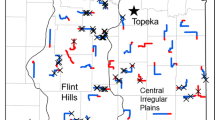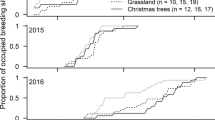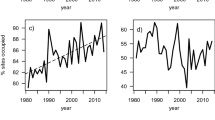Summary
In 1981–1985, we studied territory dynamics in a southeastern Idaho sage sparrow population to evaluate the hypothesis that territory shifts represent adaptive adjustments in site use. We predicted that shifts should (1) result in changes in territory characteristics, (2) be influenced by previous reproductive success and result in greater success, and (3) decline in magnitude for individual males over time. Habitat features of territories changed little as a result of shifts, but territory size increased. Correspondingly, habitat features of territories were unrelated to reproductive success, whereas territory size was positively related. The magnitude of territory shifts was negatively correlated with preshift fledging success, and after shifts, males experienced greater average reproductive success than before. Successive territory shifts by individual males became progressively smaller. Thus, territory shifting by sage sparrows seems to be adaptive behavior aimed primarily at increasing territory size.
Similar content being viewed by others
References
Anderson JE, Holte KE (1981) Vegetation development over 25 years without grazing on sagebrush-dominated rangeland in southeastern Idaho. J Range Manage 34:25–29
Baeyens G (1981) Functional aspects of serial monogamy: the magpie pair-bond in relation to its territorial system. Ardea 69:145–166
Bartels PJ (1984) Extra-territorial movements of a perennially territorial damselfish, Eupomacentrus dorsopunicans Poey. Behaviour 91:312–322
Bédard J, LaPointe G (1984) Banding returns, arrival times, and site fidelity in the savannah sparrow. Wilson Bull 96:196–205
Bédard J, LaPointe G (1985) Influence of parental age and season on savannah sparrow reproductive success. Condor 87:106–110
Beletsky LD, Orians GH (1987) Territoriality among male redwinged blackbirds. I. Site fidelity and movement patterns. Behav Ecol Sociobiol 20:21–34
Best LB (1977) Territory quality and mating success in the field sparrow (Spizella pusilla). Condor 79:192–204
Best LB, Petersen KL (1982) Effects of stage of the breeding cycle on sage sparrow detectability. Auk 99:788–791
Blancher PJ, Robertson RJ (1985) Site consistency in kingbird breeding performance: implications for site fidelity. J Anim Ecol 54:1017–1027
Brooke M deL (1979) Differences in the quality of territories held by wheatears (Oenanthe oenanthe). J Anim Ecol 48:21–32
Brown JL (1964) The evolution of diversity in avian territorial systems. Wilson Bull 76:160–169
Brown JL, Orians GH (1970) Spacing patterns in mobile animals. Annu Rev Ecol Syst 1:239–262
Conner RN, Anderson ME, Dickson JG (1986) Relationships among territory size, habitat, song, and mating success of northern cardinals. Auk 103:23–31
Daubenmire RF (1959) A canopy-coverage method of vegetational analysis. Northwest Sci 33:43–64
Davies NB (1976) Food, flocking and territorial behavior of the pied wagtail (Motacilla alba yarrellii) in winter. J Anim Ecol 45:235–253
Davies NB (1978) Territorial defence in the speckled wood butterfly (Pararge aegeria): the resident always wins. Anim Behav 26:138–147
DeBoer JN, Heuts BA (1973) Prior exposure to visual cues affecting dominance in the jewel fish, Hemichromis bimaculatus Gill 1862 (Pisces, Cichlidae). Behaviour 44:299–321
Dhondt A, Huble J (1968) Age and territory in the great tit (Parus major L.). Angew Ornithol 3:20–24
Finck E (1984) Male dickcissel behavior in primary and secondary habitats. Wilson Bull 96:672–680
Fitzpatrick SM, Wellington WG (1983) Insect territoriality. Can J Zool 61:471–486
Fretwell SD (1969) Dominance behavior and winter habitat distribution in juncos (Junco hyemalis). Bird-Banding 40:1–25
Fretwell SD, Lucas HL Jr (1969) On territorial behavior and other factors influencing habitat distribution in birds. I. Theoretical development. Acta Biotheor 19:16–36
Gottfried BM (1978) An experimental analysis of the interrelationship between nest density and predation in old-field habitats. Wilson Bull 90:643–646
Graves JA, Whitson A, Henzi P (1986) Reproductive success and the location of the nest site in the territory of the herring gull Larus argentatus. Bird Study 33:46–48
Greenwood PJ, Harvey PH (1976) The adaptive significance of variation in breeding area fidelity of the blackbird (Turdus merula L.). J Anim Ecol 45:887–898
Harvey PH, Greenwood PJ, Campbell B, Stenning MJ (1984) Breeding dispersal of the pied flycatcher (Ficedula hypoleuca). J Anim Ecol 53:727–736
Hensler GL, Nichols JD (1981) The Mayfield method of estimating nesting success: a model, estimators and simulation results. Wilson Bull 93:42–53
Hinde RA (1956) The biological significance of the territories of birds. Ibis 98:340–365
Hixon MA (1980) Food production and competitor density as the determinants of feeding territory size. Am Nat 115:510–530
Hogstedt G (1981) Effect of additional food on reproductive success in the magpie (Pica pica). J Anim Ecol 50:219–229
Howard HE (1920) Territory in bird life. Dutton, New York
Johnson DH (1979) Estimating nest success: the Mayfield method and an alternative. Auk 96:651–661
Kitchen DW (1974) Social behavior and ecology of the pronghorn. Wildl Monogr 38
Kluyver HN, Tinbergen L (1953) Territory and regulation of density in titmice. Arch Neerl Zool 10:265–286
Knapton RW (1979) Optimal size of territory in the clay-colored sparrow, Spizella pallida. Can J Zool 57:1358–1370
Kodric-Brown A (1978) Establishment and defence of breeding territories in a pupfish (Cyprinodontidae: Cyprinodon). Anim Behav 26:818–834
Krebs JR (1971) Territory and breeding density in the great tit Parus major L. Ecology 52:2–22
Mayfield HF (1975) Suggestions for calculating nesting success. Wilson Bull 87:456–466
Middleton ALA (1979) Influence of age and habitat on reproduction by the American goldfinch. Ecology 60:418–432
Newton I, Marquiss M (1982) Fidelity to breeding area and mate in the sparrowhawk Accipiter nisus. J Anim Ecol 51:327–341
Orians GH (1969) On the evolution of mating systems in birds and mammals. Am Nat 103:589–603
Page GW, Stengel LE, Winkler DW, Swarth CW (1983) Spacing out at Mono Lake: breeding success, nest density, and predation in the snowy plover. Auk 100:13–24
Petersen KL, Best LB (1985) Nest-site selection by sage sparrows. Condor 87:217–221
Petersen KL, Best LB (1987) Effects of prescribed burning on nongame birds in a sagebrush community. Wildl Soc Bull 15:317–329
Petrie M (1984) Territory size in the moorhen (Gallinula chloropus): an outcome of RHP asymmetry between neighbors. Anim Behav 32:861–870
Price TD (1984) Sexual selection on body size, territory and plumage variables in a population of Darwin's finches. Evolution 38:327–341
Rich T (1980) Territorial behavior of the sage sparrow: spatial and random aspects. Wilson Bull 92:425–438
Ross HA (1980) The reproductive rates of yearling and older ipswich sparrows, Passerculus sandwichensis princeps. Can J Zool 58:1557–1563
Shields WM (1984) Factors affecting nest and site fidelity in Adirondack barn swallows. Auk 101:780–789
Wells KD (1977) Territoriality and male mating success in the green frog (Rana clamitans). Ecology 58:750–762
Whitham TG (1986) Costs and benefits of territoriality: behavioral and reproductive release by competing aphids. Ecology 67:139–147
Wiens JA (1969) An approach to the study of ecological relationships among grassland birds. Ornithol Monogr 8
Wiens JA, Rotenberry JT (1981) Habitat associations and community structure of birds in shrubsteppe environments. Ecol Monogr 51:21–41
Winter BM (1984) Effects of prescribed burning on avian foraging ecology and arthropod abundance in sagebrush-grassland. MS thesis, Iowa State Univ, Ames, Iowa
Zimmerman JL (1984) Nest predation and its relationship to habitat and nest density in dickcissels. Condor 86:68–72
Author information
Authors and Affiliations
Rights and permissions
About this article
Cite this article
Petersen, K.L., Best, L.B. Territory dynamics in a sage sparrow population: are shifts in site use adaptive?. Behav Ecol Sociobiol 21, 351–358 (1987). https://doi.org/10.1007/BF00299929
Received:
Accepted:
Issue Date:
DOI: https://doi.org/10.1007/BF00299929




